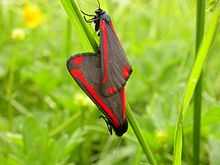Cinnabar moth
| Tyria jacobaeae Cinnabar moth | |
|---|---|
.jpg) | |
 | |
| Tyria jacobaeae on ragwort plant | |
| Scientific classification | |
| Kingdom: | Animalia |
| Phylum: | Arthropoda |
| Class: | Insecta |
| Order: | Lepidoptera |
| Family: | Arctiidae |
| Genus: | Tyria |
| Species: | T. jacobaeae |
| Binomial name | |
| Tyria jacobaeae (Linnaeus, 1758) | |
| Synonyms | |
| |
The cinnabar moth (Tyria jacobaeae) is a brightly coloured arctiid moth, found in Europe and western and central Asia. It has been introduced into New Zealand, Australia and North America to control poisonous ragwort, on which its larvae feed. The moth is named after the red mineral cinnabar because of the red patches on its predominantly black wings. Cinnabar moths are about 20mm long and have a wingspan of 32–42 mm (1.3-1.7 in).
Cinnabar moths are day-flying insects. Like many other brightly coloured moths, it is unpalatable; the larvae use members of the genus Senecio as foodplants. Many members of the genus have been recorded as foodplants, but for long-term population success, the presence of the larger species such as ragwort is needed. Smaller plant species, such as groundsel, are sometimes used, but since the species lays its eggs in large batches, survival tends to be reduced. Newly hatched larvae feed from the underneath of ragwort leaves within the area of their old eggs. The larvae absorb toxic and bitter tasting alkaloid substances from the foodplants, and assimilate them, becoming unpalatable themselves.[1] The bright colours of both the larvae and the moths act as warning signs, so they are seldom eaten by predators. An exception is among different species of Cuckoo which eat hairy and poisonous caterpillars including cinnabar moth larvae.[2]
Like several other Arctiidae moth larvae, the cinnabar caterpillars can turn cannibalistic. This can be due to lack of food, but they can eat other cinnabar larvae for no apparent reason. Females lay up to 300 eggs, usually in clusters of 30 to 60. Initially, the larvae are pale yellow, but later larval stages develop the jet black and orange/yellow striped colouring. They can grow up to 30mm, and are voracious eaters; large populations can strip entire patches of ragwort clean, a result of their low predation.
Often, very few survive to the pupal stage, mainly due to them completely consuming the food source before reaching maturity; this could be a possible explanation for their tendency to engage in seemingly random cannibalistic behaviour, as many will die from starvation. Additionally, the larvae are predated by species like the ants Formica polyctena.[3]
The moth has proven to be particularly successful as a biocontrol agent for ragwort when used in conjunction with the ragwort flea beetle in the western United States.[4]
-
.jpg)
Adult showing hindwings
-

Mating
-

Illustration from John Curtis's British Entomology Volume 5
| Wikimedia Commons has media related to Tyria jacobaeae. |
References
- ↑ "Cinnabar moth". A Nature Observer′s Scrapbook. bugsandweeds.co.uk. June 2007. Retrieved 2007-12-21.
- ↑ Burton, Robert (2002). The International Wildlife Encyclopedia, Volume 1 (3rd ed.). Benchmark Books. p. 618.
- ↑ Haccou, P. and L. Hemerik. “The Influence of Larval Dispersal in the Cinnabar Moth (Tyria jacobaeae) on Predation by the Red Wood Ant (Formica polyctena): An Analysis Based on the Proportional Hazards Model.”Journal of Animal Ecology , Vol. 54, No. 3 (Oct., 1985).
- ↑ Coombs, E. M., et al., Eds. (2004). Biological Control of Invasive Plants in the United States. Corvallis: Oregon State University Press, 344.

_head.jpg)